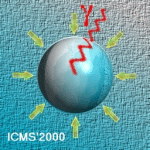
ICMS'2000
The International Conference on Multiphase Systems, ICMS'2000
Ufa, RUSSIA, June 15-17, 2000
Moraga F. J.
Oak Ridge Associated Universities, Oak Ridge, TN. USA
Taleyarkhan R. P.
Oak Ridge National Laboratory, Oak Ridge, TN. USA
Lahey R.T., Jr.
Rensselaer Polytechnic Institute, Troy, NY, USA
Bonetto F. J.
Instituto Balseiro/CNEA-CAB, Bariloche, Argentina
The fundamental and tenth harmonics were used to produce stable single bubble sonoluminescence in water. By varying the phase difference between the harmonics it is possible to enhance the sonoluminescence light emission by as much as a factor of 2.7 compared with single frequency excitation. Absolute measurements of the bubble radius evolution were carried out using the two- detector technique. Unlike previous observations, these measurements and complementary fits of the Rayleigh-Plesset equation reveal that the maximum bubble radius does not change significantly with phase angle between the harmonics. Therefore, increased SL intensity does not have to correlate with increases in maximum bubble radius prior to collapse. We believe that a more violent bubble collapse rate (driven by the very high frequency component) is responsible for the enhanced light emission under this type of mixed excitation. It was further found that, the mere presence of the tenth harmonic frequency component (i.~e., even at lowest achievable amplitudes in our system and with no phase difference optimization) led to significant enhancements in the stability of the bubble undergoing SL. This allowed the bubble to be driven (with pressure amplitudes close to 2 bar, which are significantly above often reported thresholds of 1.4~bar) at the fundamental frequency itself, thereby leading to increased levels of light emission (by more than 250\%).